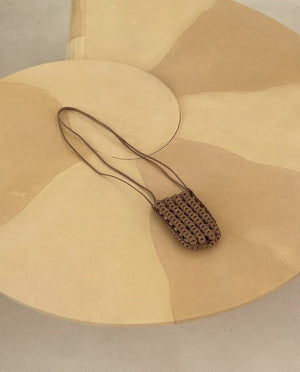An Interview with NATHANIEL KYUNG SMITH AND KOURTNEY KYUNG SMITH of COMMON BODY.
1. Can you tell us about Common Body and how it came to be?
K: We began Common Body in 2016 with a collection of baltic birch furniture. Our original vision was to create a collaborative experimental studio that designed objects, spaces and experiences. At the time, we were inspired by modernist art collectives like Black Mountain College, the Dadaists, and Bauhaus and how they brought formal principles to multi-disciplinary and multi-media practices. We took a hiatus for several years while getting married and building other art practices, then relaunched Common Body at the end of 2019 as a central place for Nathaniel's sculpture practice to live and grow.
2. How did the pandemic affect your practice –– this can be tangible or just in the way that you have thought about your work.
N: The pandemic created a focused place to establish some of the structure around CB. We were able to isolate ourselves in our home without distractions and develop a visual language for our project, which is tedious but necessary. We also delved into research to connect our practice to broader themes in art history, one of Kourtney's main interests. If anything, the global challenges of this past year further affirmed my sculpture practice is where I want to be spending my time and energy.
3. Some of your objects seem to carry a suggestion of ritual. What are some rituals, or activities, outside of CB keeping you grounded and interested currently?
K: Ritual is an interesting part of our studio practice. When we conceived of Common Body, we were thinking a lot about community and the connection of bodies through a shared creative vision and body of work. Connection to our own physicality and the interconnectivity of nature (people included) is very important to us. We make everything ourselves, it's a very tactile process which we find to be grounding and meditative.
We also have begun practicing ballet together each morning, which connects us to our childhoods as young movers and our physical selves in valuable ways. Dance taps into that deep well of human knowing and learning from self.
4. Can you tell us about the process and materials that you use?
N: Everything comes from a drawing. I focus on the silhouette and pull inspiration from the human form, movement, and shape relationships. I approach my drawings automatically, trying to turn off my analytical mind and draw from instinct. I reference my drawings for my sculpture forms and hand build the sculptures from local high-fire stoneware clay in my home studio. We like to source our materials as close to home as possible to minimize the environmental impact and to support the ecosystems around us.
5. You call CB an ‘exploratory creative studio,’ what explorations can we expect from CB in the future?
K: We want the freedom to make whatever we want when the inspiration strikes. We'll definitely continue to play with new mediums and forms. We’ve worked with marble, limestone, ceramic, wood, plaster, beeswax, butter and we plan to expand into bronze this year. Nate also has some large-scale sculpture commissions in the works that we're excited about.
6. For your Recline Series you write, “each unique character in this series explores ideas around a kind of self gaze, voyeurism in catching one’s own reflection. An effigy for our self-communion as a physical object.” What led you to make figurative work in particular—how is it an exploration of identity?
N: I think one's relationship with self is the most fundamental and important relationship. I’ve been thinking a lot about self-love recently and how important it is to achieving personal freedom. Our bodies are bound by physical limitations and systems of control, and the more we unburden ourselves from these systems and listen to what our bodies need, the more we enable them to move with creativity, symbiosis and care. Self-love is about really giving ourselves the tools we need to flourish and learning to trust our instincts. I make figurative work as a way to honor and reflect on the potential of what the body can offer us.
K: Abstract figuration is a practice in freeing the body (and ultimately the self) from the expectations and laws imposed. The early modernists understood this freedom as an active rebellion from the limitations of naturalism and tradition. They acknowledged that bodies were controlled for-profit and squandered for political gain like in the devastating casualties of the Great Wars. Abstracting the figure gave artists autonomy over the body; it let them make new rules and envision new realities. I think these figures flow out of Nate for a similar reason: a necessary practice in freedom, play, and possibility. It's really what we both are working toward as artists, to feel boundless.
Shop Common Body at LoQ Objects.
Learn more about Common Body here.
Photography by Kourtney Kyung Smith.
